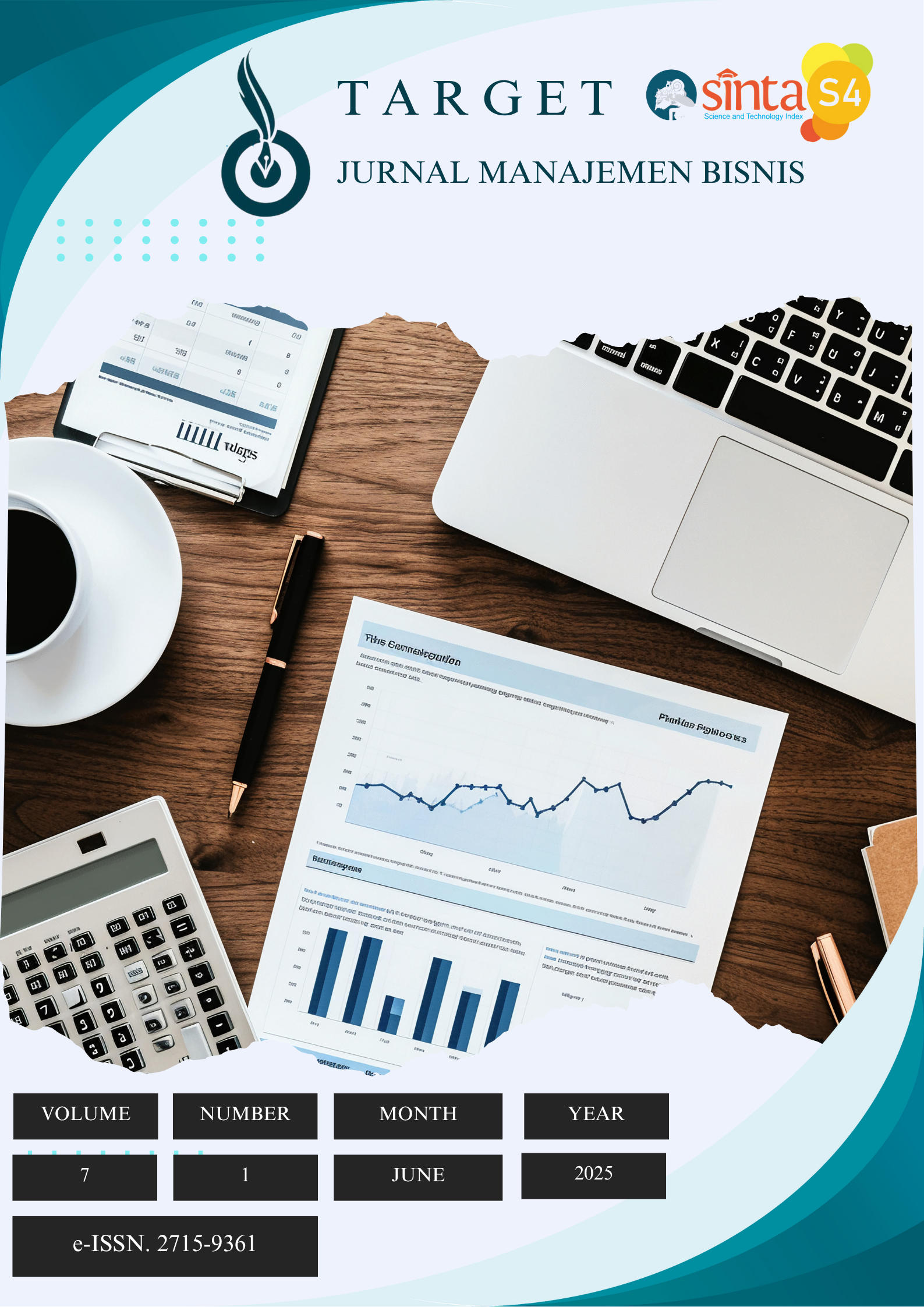Implementation of Artificial Intelligence for Green Human Resource Management
DOI:
https://doi.org/10.30812/target.v7i1.4837Keywords:
Artificial Intelligence, Green Human Resource, Human Resource Management, ManagementAbstract
The development of technology, particularly in the field of Artificial Intelligence (AI), has had aprofound impact on various aspects of organizational management, including Human Resource Manage- ment (HRM). This study aims to examine the application of Artificial Intelligence in HR that is oriented towards environmentally friendly principles. This study employs a qualitative approach with a case study method, where data collection techniques are carried out through in-depth interviews with all parties directly involved in human resource management at Company X, namely one company owner and 13 employees. The study’s results indicate that Company X has effectively implemented AI technology in its human resource management. The application of this technology is not intended to replace the role of humans in HR, but to support and improve work efficiency. The AI software used enables companies to monitor employee activities and productivity more efficiently and in greater detail. The entire pro- cess in human resource management, from recruitment to employee management, is still carried out by involving humans. The use of this technology has also been shown to minimize human error and lighten the conventional workload of the HRD department, making work more time-saving and efficient. The theoretical implications of this study’s findings suggest that integrating AI in HR can strengthen modern management theory, which emphasizes the importance of efficiency, effectiveness, and sustainability in organizational management.
References
[1] W. Nikmah, A. Mukarromah, D. Widyansyah, and M. I. Anshori, “Penggunaan Teknologi dalam Pengembangan SDM,” Mutiara : Jurnal Penelitian dan Karya Ilmiah, vol. 1, no. 5, pp. 366– 386, Oct. 2023, issn: 2988-3148, 2988-313X. doi: 10.59059/mutiara.v1i5.511.
[2] E. P. Astutik, N. A. Ayuni, and A. M. Putri, “Artificial Intelligence: Dampak Pergeseran Pe- manfaatan Kecerdasan Manusia dengan Kecerdasan Buatan bagi Dunia Pendidikan di Indonesia,” Sindoro: Cendikia Pendidikan, vol. 1, no. 10, pp. 31–40, Dec. 2023. doi: 10.9644/sindoro. v1i10.1219.
[3] M. Siahaan, C. H. Jasa, K. Anderson, M. V. Rosiana, S. Lim, and W. Yudianto, “Penerapan Artifi- cial Intelligence (AI) Terhadap Seorang Penyandang Disabilitas Tunanetra,” Journal of Informa- tion System and Technology (JOINT), vol. 1, no. 2, pp. 186–193, Dec. 2020, issn: 2775-0272. doi: 10.37253/joint.v1i2.4322.
[4] S. Nurcahyani, Z. Husain, D. E. Prastya, and R. Agusentoso, “Peran Teknologi Artificial Intelli- gence dalam Pengembangan Sumber Daya Manusia,” Prosiding Seminar Nasional Manajemen, vol. 4, no. 1, pp. 1091–1095, 2025, issn: 2830-5353.
[5] S. Sewang, A. N. A. Ainun, and M. Misrah, “Artificial intelligence dalam Rekrutmen dan Seleksi Karyawan : Manfaat dan Tantangannya,” Jurnal Publikasi Manajemen Informatika, vol. 3, no. 3, pp. 69–77, Sep. 2024, issn: 2808-9014, 2808-9359. doi: 10.55606/jupumi.v3i3.3685.
[6] M. Haenlein and A. Kaplan, “A Brief History of Artificial Intelligence: On the Past, Present, and Future of Artificial Intelligence,” California Management Review, vol. 61, no. 4, pp. 5–14, Aug. 2019, issn: 0008-1256, 2162-8564. doi: 10.1177/0008125619864925.
[7] A. H. Putra, N. Neviyarni, and F. Firman, “Bimbingan dan Konseling di Perguruan Tinggi pada Era Society 5.0,” Jurnal Ilmu Pendidikan dan Sosial, vol. 1, no. 1, pp. 128–136, Jul. 2023, issn: 2829-2723. doi: 10.58540/jipsi.v1i1.24.
[8] D. Olazo and J. A. Evaristo, “The Role of Artificial Intelligence in Promoting Employee Workplace Green Behaviors: A Systematic Analysis,” SEISENSE Business Review, vol. 5, no. 1, pp. 15–28, Mar. 2025, issn: 2788-7561. doi: 10.33215/2hddey70.
[9] M. N. Jatobá, J. J. Ferreira, P. O. Fernandes, and J. P. Teixeira, “Intelligent human resources for the adoption of artificial intelligence: A systematic literature review,” Journal of Organizational Change Management, vol. 36, no. 7, pp. 1099–1124, Dec. 2023, issn: 0953-4814. doi: 10.1108/ JOCM-03-2022-0075.
[10] N. Ali, S. W. Milang, F. F. A. Sagaf, and N. Ladjin, “Digital Transformation in Green HRM: Implementation of HR Analytics to Improve HR Sustainability in Manufacturing Companies in Bandung City,” Journal of Management, vol. 4, no. 1, pp. 52–64, Mar. 2025, issn: 3026-3239.
[11] C. L. Z. DuBois and D. A. Dubois, “Strategic HRM as social design for environmental sustainability in organization,” Human Resource Management, vol. 51, no. 6, pp. 799–826, Nov. 2012, issn: 0090-4848, 1099-050X. doi: 10.1002/hrm.21504.
[12] S. Sugiyono, Metode Penelitian Bisnis: Pendekatan Kuantitatif, Kualitatif, Kombinasi, Dan R&D. Bandung: Alfabeta, 2019.
[13] I. Obaid, M. S. Farooq, and A. Abid, “Gamification for Recruitment and Job Training: Model, Taxonomy, and Challenges,” IEEE Access, vol. 8, pp. 65 164–65 178, 2020, issn: 2169-3536. doi: 10.1109/ACCESS.2020.2984178.
[14] L. Liang, L. Lu, and L. Su, “The impact of industrial robot adoption on corporate green innovation in China,” Scientific Reports, vol. 13, no. 1, p. 18 695, Oct. 2023, issn: 2045-2322. doi: 10.1038/ s41598-023-46037-8.
[15] H. Wang and C.-T. Sun, “Game reward systems: Gaming experiences and social meanings,” in Proceedings of DiGRA 2011 Conference: Think Design Play, Jan. 2011. doi: 10.26503/dl. v2011i1.594.
[16] Deepika R and Dr KarpagamV, “A study on green HRM practices in an organisation,” Interna- tional Journal of Applied Research, vol. 2, no. 8, pp. 426–429, Aug. 2016, issn: 2394-5869.
Downloads
Published
Issue
Section
License
Copyright (c) 2025 Sindi Budi Emilia

This work is licensed under a Creative Commons Attribution 4.0 International License.








